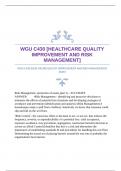WGU C430 [HEALTHCARE QUALITY
IMPROVEMENT AND RISK
MANAGEMENT]
WGU C430 [HEALTHCARE QUALITY IMPROVEMENT AND RISK MANAGEMENT]
EXAM
Risk Management- protection of assets (part 1) - ACCURATE
ANSWER✅✅•Risk Management - identifying and proactive decisions to
minimize the effects of potential loss situations and developing strategies of
avoidance and prevention (identification and analysis) (Risk Management) A
housekeeper mops a spill from a hallway. Intuitively we know that someone could
slip and fall on the wet floor.
•Risk Control - the conscious effort or decision to act, or not act, that reduces the
frequency, severity, or unpredictability of a potential loss. (risk acceptance,
exposure avoidance, loss prevention, segregation, contractual transfer) decision to
act/not act (Risk Control) Identifies that this is a risk and determines the
importance of establishing standards & and procedures for handling this wet floor.
Determining the actual act of placing barriers around the wet area is probably the
organization's best interest.
,Risk Management- protection of assets (part 2) - ACCURATE
ANSWER✅✅•Loss Control - the ability to minimize the actual loss (response to
the loss, loss reduction) (Loss control) Someone is not paying attention, walks
through the barriers, and slips on the floor, hurting their back. Now there is a loss.
The goal of loss control is to minimize the cost of that loss once the fall occurs,
however, no one in the organization can determine the actual cost; it could be a
dollar it could be a hundred thousand dollars. In other words, once the loss occurs,
no one has control of the consequences. So minimization of the cost is essential.
This occurs by developing protocols for handling the injury and thus reducing the
cost of that event. The control can take the form of transporting the injured person
to the ER if it's an employee assigning a case manager to assist the employee after
they have seen a physician who diagnoses the injury. That assistant can help them
schedule a follow-up doctor appointment, and physical therapy appointments, and
communicate with the employee constantly.
•Loss Management - proactive activities to return the organization to its pre-
existing state. Another definition states that risk management is a program
designed to reduce the incidence of preventable accidents and injuries to minimize
the financial loss to the institution should an injury or accident occur. (loss
management) attempts in the case of the employee, to return the injured worker to
their job, when medically cleared.
Health Care Assets (part 1) - ACCURATE ANSWER✅✅What is Risk?
Uncertainty about future events that may threaten the safety of patients and the
assets and reputations of providers. Quick review about risk: risk is about
uncertainty. No one knows what's going to happen in the future that may threated
the organizations.
Health Care Assets (part 2) - ACCURATE ANSWER✅✅What do we mean by
assets? *People-patients, clinicians, volunteers, and employees.
Assets. The threat could come from patient activities, an employee, damage to
equipment, or the failure to adhere to contractual expectations. Or it could be the
loss of the organization's reputation due to an illegal activity. What needs to be
understood is; that there is always a potential for bad outcomes and risk
management should attempt to plan for these unintended consequences. What are
, our healthcare organizations' assets that need to be protected? We are trying to
protect the patients, volunteers, and employees; anybody that is a stakeholder in
that organization.
*property-buildings, facilities, equipment, and materials. Property is an asset. How
are the buildings, the facilities, the equipment, and the inventory being taken care
of? How are they being exposed to potential losses? What is being done to protect
that?
Health Care Assets (part 3) - ACCURATE ANSWER✅✅*Financial revenue,
reserves, grants, and reimbursement. Financial assets, how should the revenue,
reimbursement, reserves, grants, or any dollar asset be protected?
*Goodwill health and well-being, reputation, and stature in the community.
Goodwill is the reputation of the organization. What is the stature in the
community? How do people view the organization? How are we protecting the
goodwill or the reputation of the organization? Goodwill appears on the balance
sheet, there is a financial value associated with goodwill, so protecting it is
essential. What would happen to the goodwill of the organization if an employee
sexually assaulted an unconscious patient in the intensive care unit? If this event
was reported to the newspaper, what would the impact be on the organization's
reputation? These are just a few risks that need to be considered. Errors happen all
the time in healthcare.
Medical errors are everywhere (part 1) - ACCURATE ANSWER✅✅Hospital
employees recognize and report 1 in 7 medical errors that harm Medicare patients.
Even after medical errors are reported and investigated, many hospitals do not
change their practices to prevent the repetition of the event.
Let's use medical errors as an example. We're going to talk about the errors
associated with actual care given to patients. Remember, risk management attempts
to identify where potential losses can occur. By looking at care, as a small example
of these losses, we can better improve outcomes. A report titled. To Err is Human:
Building a Safe Health Care System was published several years ago. This report
highlighted between 140,000 and up to 900,000 people die or are injured while
under the care of healthcare workers. These are known errors. Even when an error
is discovered 1:7 are reported. It should be obvious that many go unreported. The




